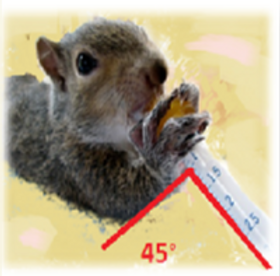Squirrel Feeding Techniques

Feeding an orphaned squirrel requires the right tools, positioning, speed, and frequency. Make sure to learn the proper techniques before attempting to feed a squirrel.
On this page, you'll find the steps necessary to properly prepare, transition, and feed a baby squirrel as well as links to other necessary information.
If this information isn't enough and if you need additional help, please call us or speak with another qualified rehabilitator to get the training or assistance you require.
Preparing Formula for Squirrels
Mix 2 parts warm water with one part Fox Valley formula and mix well. Store mixed formula in refrigerator for up to 48 hours.
Milk replacement for babies transitioning to formula or those with stool or digestive problems should be supplemented with a small amount of acidophilus (1/8 tsp) per ¼ cup mixed formula. As a preventative measure, it is acceptable to always add a pinch of acidophilus to the formula right before feeding.
If this is the first time you are offering formula to the baby, the baby must be fully hydrated and slowly transitioned onto full strength formula. Reference the section below entitled, ‘Transitioning to Formula’
Feeding Preparation
Warm only the formula you will be using for a single feeding. Excess formula may be used later if refrigerated. The formula should be reasonably warm to the touch when squirted on the inside of your wrist, but not hot. Add a pinch of acidophilus powder for digestive support to the warmed formula and mix well.
Fill the syringe with the formula and acidophilus mixture. Tightly squeeze a nipple onto the end. The nipple should not easily pull off when gently tugged. The nipple selected must not be small enough to be aspirated into the baby’s lungs.
REMEMBER
Never feed a cold baby and always stimulate a baby under six weeks old or whose eyes are still closed to eliminate after every feeding!
Feeding Hygiene
Wash your hands before and after feeding the baby. Don’t use strong smelling hand soap or lotions as baby’s sense of smell is extraordinarily acute! Also, babies don’t like cold hands.
Place the nipple against the mouth of the squirrel and squeeze out a little milk. Most babies will start by licking the milk but then rapidly progress to sucking very hard. Press the syringe plunger down very slowly, controlling the rate of feeding. If milk bubbles out of the nose, the baby starts gaping or making a ‘guppy face’, immediately pull the nipple out of the baby’s mouth.
Reference the ‘Controlling Feeding Rate’ section. Do not try to force fluids into a baby unwilling or unable to swallow.
Feeding Position
Always feed the baby in an upright position in warm conditions with good lighting so that you can monitor the squirrel’s swallowing reflex.
If the baby does aspirate fluids, pull the nipple away from the mouth, and (while firmly supporting the head and body) with a few gentle rapid forward motions, tip the baby forward to help gravity drain the fluid from the nose, blot the nostrils.
When the baby is calm and the airways are clear, resume feeding.
Important! much like avoiding ‘shaken baby’ syndrome in humans, don’t ever shake or jerk a baby’s head.

If your baby aspirates fluids frequents, try using a smaller syringe, a nipple with a smaller hole, or pressing your thumb against the side of the plunger. Reference the link entitled, ‘Feeding Complications’
Controlling the Feeding Rate
Squirrels can be pigs and will frequently suck very hard and will, if given the opportunity, over eat. Overeating is not ever a good thing!
Signs you are feeding too quickly: the baby makes a yawning motion, milk bubbles from the nose or mouth and sneezing. Resolution: stop it. To help accomplish that, use a ‘slower’ nipple (smaller hole) and or a smaller size syringe that provides better control. If the baby sucks so hard that the syringe plunger rapidly moves on its own down the barrel, place your thumb against the plunger to add additional resistance and slow the flow.
Transitioning to Formula
After the baby is warm, properly hydrated (usually on an electrolyte hydration fluid like Pedialyte for 12 to 24 hours, and alert the baby must be transitioned over to full strength formula gradually over several feedings. Introducing formula to quickly will result in life threatening diarrhea and bloat.
Over the next six feedings, increase the strength of the formula according to the schedule below. If no diarrhea or bloating occurs after transition, continue feeding the baby the full strength formula according to the Standard Feeding Schedule. Formula is always mixed with water and not a hydration fluid because the formula already contains electrolytes.

